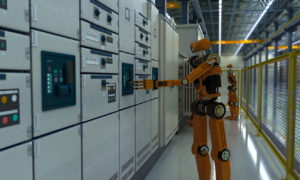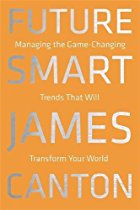Think Like a Futurist to Build More Effective Strategic Communications
Eight tips on how to embrace a futurist mindset into your strategic communications planning.
By Stephen Dupont, APR
Imagine, if you will, working in the year 2030, just a mere 12 years away.
Today’s Millennials will be squarely in their forties, and today’s Generation Z (those born from 1996 to the present, 2018) will be entering their early thirties. And Gen Xers? They will be tomorrow’s 60-year-olds.
Aging statistics aside, the next decade will bring a myriad of change that will dramatically affect a wide range of industries. Some of these changes will include:
— Driverless vehicles;
— The Internet of Things (using sensors and other technology to gather data on just about anything, from agricultural crops to reducing energy waste throughout your home);
— Robots in the workplace (for example, hospitals, nursing homes, police beats, military applications and factories);

— Artificial intelligence (machines teaching other machines how to do perform specific tasks);
— Deliveries by drone;
— Genetic engineering;
— Virtual reality and augmented reality; and
— Voice-activated search and smart homes and offices.
These and many other new technologies will affect how every person — from surgeons to police officers, from teachers to finance executives — will go about their work and perform the jobs that not only meet the needs of their customers, but create new value.
As a strategic communicator, are you prepared to start thinking like a futurist to communicate how these changes will affect your:
- Customers;
- Employees;
- Investors;
- Vendors;
- Government regulators; and
- Other key stakeholders and influencers?

For example, imagine communicating business decisions such as:
— Same-day delivery of products with commercially approved drones to the front doors of your customers;
— Announcing the layoff of employees whose work will be replaced by a powerful new software system powered by AI;
— Informing customers that their products will be shipped by your company with driverless, electric-powered trucks; or
— Building a virtual store that allows customers to talk with company avatars while simultaneously touching your company’s products (in 3D imaging) in real time through virtual reality headsets and sensor gloves.
According to numerous futurists with whom I have interviewed for my blog, stephendupont.co, the pace of change is not only increasing, but is colliding against other factors such as globalization, artificial intelligence/software automation, climate change, and life-altering medical breakthroughs. These disruptive changes may result in:
— Large portions of our population living active lives well into their 100s;
— Growing numbers of Americans who will need career re-training as robots and artificial intelligence do their jobs at a fraction of the cost;
— Large coastal populations around the world and in the U.S. (Florida, the Gulf Coast of Texas, New York City, Boston, etc.) being displaced by rising seas;
— New cryptocurrencies (Bitcoin, Ether, Litecoin) being used alongside U.S. dollars to purchase products and services.
With change comes uncertainty, but also tremendous excitement for advancements that could make life better. Imagine:
— Police officers trained in using drones to spot illegal sex trafficking activity in the streets major cities;
— The use of robots to help firefighters detect the presence of harmful chemicals during a fire;
— Teachers using virtual reality headsets to have their students experience what life in your state was like back in the 1800s; and
— New jobs being created to support the new colonies on the Moon and Mars, as well as the robotic mining of nearby asteroids.
What can you do now to start developing a futurist mindset and strategically apply that mindset for your company or clients? Here are six tips to start acting on now:
 1.) Read more – Reading has never been more important to learn new perspectives, understand the past, and imagine the implications of new systems and technologies. What should you read? Focus on books offering differing perspectivs about the future and new technology. Read about how your industry has changed over the past 20, 50 or even 300 years. Look for information about how your industry will be affected by demographic change. Read science fiction to imagine possible futures for those in your industry (What kind of cars would be drive on Mars? What kind of food will we eat when Earth’s population is 10 billion?) Reading, watching interesting videos and movies, and listening to podcasts can help you imagine the possibilities. Looking for some suggestions? Go to stephendupont.co/reading-list.
1.) Read more – Reading has never been more important to learn new perspectives, understand the past, and imagine the implications of new systems and technologies. What should you read? Focus on books offering differing perspectivs about the future and new technology. Read about how your industry has changed over the past 20, 50 or even 300 years. Look for information about how your industry will be affected by demographic change. Read science fiction to imagine possible futures for those in your industry (What kind of cars would be drive on Mars? What kind of food will we eat when Earth’s population is 10 billion?) Reading, watching interesting videos and movies, and listening to podcasts can help you imagine the possibilities. Looking for some suggestions? Go to stephendupont.co/reading-list.
2.) Practice visualization – What separates a futurist from someone who makes predictions? It’s the ability to visualize future scenarios. Practice this on your own at first; then, invite work colleagues to start building their visualization skills. Start with this: Take a problem or opportunity facing your organization or client and take 10 to 15 minutes to think about it. Take notes on a piece of paper, or record your thoughts with your smart phone (audio notes). Imagine how this problem or opportunity will have evolved in five, ten or 20 years. How will it look? Who will work on it? How it will be solved or improved? Think colors, sounds, words, and images. Remember, there’s no right or wrong solution. There are many possibilities that you should record and then analyze — just as there is not one future, but many futures. Then ask this question: What future would we want for our organization or brand(s) and what could we start to do now to help us achieve that future?
3.) Ask more relevant questions – Whether it’s 2018 or 2118, the skill and art of powerful and relevant questions will never go out of style. The key is to ask questions that others have overlooked or are afraid to ask. Start by doing your homework to determine what needs to be asked. Then, practice the art of asking. Search for, and study, great interviews conducted by broadcast and print journalists. Read books, such as science fiction, or research studies about new technology, to ask questions about the impact of future technology on your organization’s customer. For more tips, go to stephendupont.co/powerful-relevant-questions.
4.) Travel more – The future you experience in 2030 will be different than, say, the future that someone in South Africa may experience. It’s in traveling to places as South Africa, Greenland or elsewhere that you will gain a better understanding about how people in other parts of the world view the future. In the process, you’ll also gain a sense of empathy needed to make future decisions. World travel is important, especially in understanding how your customers are actually using your organizations products and services on a day-to-day basis. But don’t forget to travel throughout your own community, state or province to gain a better understanding of the inter-connections between people, such as the impact of your organization on the health of local communities and small business.
5.) Embrace new technology – Learn to experiment with new technology to prepare you for a world that will only become more and more tech driven. Go have a virtual reality experience. Buy and sell a cryptocurrency. Shoot and post a video made with a drone. Create a podcast. Start a blog. Give yourself permission to try new things, and the permission to fail. More importantly – involve other leaders in your organization to help them see what’s possible or what’s coming next. It’s through using new technology that we learn how others may be harness those technologies and how they may be affected by those technologies, as well.
6.) Advocate for better futures — Futurists are ethically bound to advocate for better, more positive futures for humans (while being aware and realistic of the negative consequences of new technology or changes in public policy). As you think about possible futures for your organization, what concrete action could you take today to start advocating for a better future for those who rely upon your organization and its resources? If, for example, the future of heating and cooling our buildings will change based on new types of energy resources, what should your organization do now to start embracing that future? Should you ask the government to relax current standards, or, in watching how the trend is developing, should you embrace stricter guidelines and be the first to market with the most environmentally friendly product?

7.) Take small steps now – The future favors those who think ahead. Look closely at the near future (within the next 24 months to three years) and the long-term (five or more years). What events are highly likely to impact your organization, and what changes may affect your organization? Because most marketing and communications plans are built on a one-year fiscal year cycle, what small steps could you start to take now, knowing what you know? Could you create “mini-plans” for various “what if” scenarios? You would if it was highly likely that a key figure were going to retire within the next two years. So why not invest some thinking into what your customers, and other stakeholders, will want and expect from your brand five years from now.
8.) Stories will still matter – Regardless of whatever happens, technology-wise, by 2030, the fact is the most powerful marketing and sales tool that any organization of any type – from the start-up brewery to the multinational corporation – should cultivate is that of storytelling. Sharing the experiences of why your organization exists (and its values), the process you took to create a product, and the stories of customers using your product are potent tools in building the culture that a brand needs to attract and engage customers and other stakeholders. While we may be working alongside robots in 2030, sharing the human experience will never go out of style, and I don’t foresee robots being able to capture the spirit of those stories for some time.
The time to think about the future is now
To think strategically, you need to think not just about the challenges and opportunities that your organization (or clients) face now or within the immediate future, but the changes that will affect your stakeholders in three, five, ten or even 20 years.
Keep in mind, there are many possible futures for your organization (or clients). The question is, what is the most ideal future for your organization and its customers and employees, and what can you do now, and what should you do now, to begin building toward that ideal future?
Stephen Dupont, APR, is vice president of public relations and branded content for Pocket Hercules (www.pockethercules.com), a creative brand marketing firm based in Minneapolis. Stephen Dupont blogs about topics such as creativity, marketing, futurism and careers on blog, www.stephendupont.co. Contact him at stephen.dupont@pockethercules.com.
© Stephen Dupont, 2018